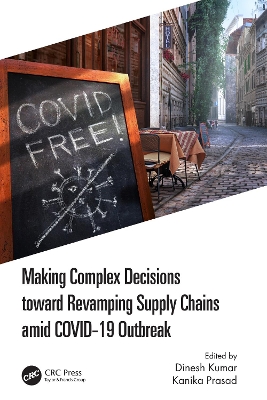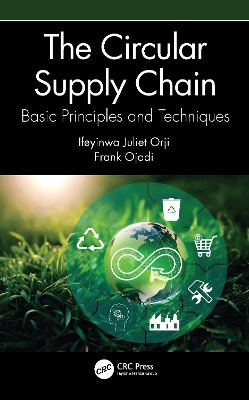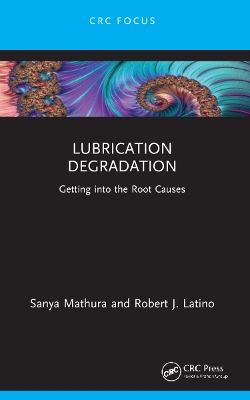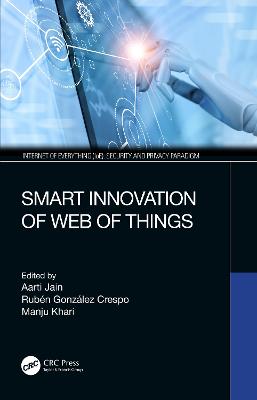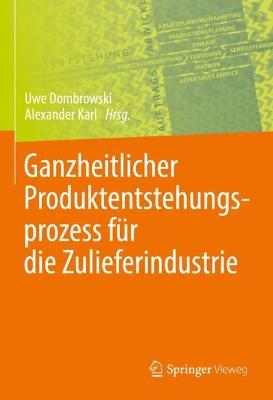Technology Innovation in Manufacturing
 portes grátis
portes grátis
Technology Innovation in Manufacturing
Khamba, Jaimal Singh; Nanda, Tarun; Singh, Davinder
Taylor & Francis Ltd
10/2024
144
Mole
9781032225340
Pré-lançamento - envio 15 a 20 dias após a sua edição
Descrição não disponível.
Chapter 1
TECHNOLOGY INNOVATION AND ITS SIGNIFICANCE
1.1 Introduction
1.2 Innovation Typology
1.3 Technology Innovation Defined
1.4 Important sources of Technology Innovation
1.5 Significance of Technological Innovation
1.6 Technological Innovation in Manufacturing Industries
1.7 Concluding Remarks
Chapter 2
GLOBALIZATION AND ITS IMPACT ON TECHNOLOGY INNOVATION
2.1 Introduction
2.2 Globalization and Fourth Industrial Revolution
2.3 Positive and negative consequences of Globalization
2.4 Effect of Globalization on Technology Innovation in Manufacturing Industries
2.5 Need for Technology Innovation in the era of Globalization
2.6 Concluding Remarks
Chapter 3
TECHNOLOGY INNOVATION INITIATIVES IN MANUFACTURING INDUSTRIES
3.1 Introduction
3.2 Technology Innovation Initiatives (TIIs)
3.2.1 Entrpreneurial Capability
3.2.2 Technology Infrastructure Capability
3.2.3 Organizational Culture and Climate
3.2.4 Government Initiatives
3.3 Concluding Remarks
Chapter 4
RELIABILITY ANALYSIS OF TECHNOLOGY INNOVATION INITIATIVES
4.1 Introduction
4.2 Analyses of Preliminary Data
4.2.1 Entrepreneurial Capability (EC) Issues
4.2.2 Technology Infrastructure Capability (TIC) Issues
4.2.3 Organization Culture and Climate (OCC) Issues
4.2.4 Government Initiative (GI) Issues
4.2.5 Manufacturing Performance Parameter (MPP) issues
4.3 Relationship between various Technology Innovation Initiatives (TIIs) and Manufacturing Performance Parameters (MPPs)
4.4 Contribution of TIIs in achieving Manufacturing Performance Enhancement
4.5 Concluding Remarks
Chapter 5
MULTI-CRITERIA DECISION-MAKING TECHNIQUES
5.1 Introduction
5.2 Evaluation of TIIs using Fuzzy Based Model
5.3 Fuzzy Interface Systems
5.3.1 Fuzzification
5.3.2 Rule Evaluation
5.3.3 Defuzzification
5.3.4 Result: Checking the Suitability of TI Measures
5.3.5 Fuzzy Evaluation Rules and Solution
5.4 Analytic Hierarchy Process (AHP)
5.4.1 Describing model structure: the sub-objectives for decision making
5.4.2 Hierarchy Formulated
5.4.3 Scale used for Pair Wise Comparison of Attributes
5.4.4 Pair-wise Comparison of Different Attributes
5.4.5 Normalization of Comparison Matrix
5.4.6 Checking for Consistency
5.4.7 Priority Weights for Alternatives
5.5 Concluding Remarks
Chapter 6
STRUCTURAL EQUATION MODELING
6.1 Introduction
6.2 Validation of Fuzzy Based TI Model through Structural Equation Modeling (SEM)
6.2.1 Instrument used: AMOS 22.0 software
6.2.2 Independent and Dependent Variables
6.2.3 Structural Equation Modeling of TI Model
6.2.4 Screening of the Data with Preliminary Analysis
6.2.5 Confirmatory Factor Analysis
6.2.6 SEM_TI Model and Result Analysis
6.2.7 Modification Indices of SEM_TI Model
6.3 Concluding Remarks
Chapter 7
Case studies
7.1 Introduction
7.2 Introduction to Industry 'A'
7.2.1 Quality Policy
7.2.2 Mission
7.2.3 Product Range
7.2.4 SWOT Analysis at Industry 'A'
7.2.5 SAP Analysis of Industry 'A'
7.2.6 LAP Synthesis of Industry 'A'
7.3 Introduction to Industry 'B'
7.3.1 Milestones
7.3.2 Product Range
7.3.3 SWOT Analysis at Industry 'B'
7.3.4 SAP Analysis of Industry 'B'
7.3.5 LAP Synthesis of Industry 'B'
7.4 Suggestions and Recommendations
7.4.1 Suggestions to the Entrepreneurs
7.4.2 Suggestions to the Government
7.4.1 Suggestions to the Banks and other Financial Institutes
7.5 Concluding Remarks
Chapter 8
CONCLUSIONS AND RECOMMENDATIONS
8.1 Introduction
8.2 Summary of the Study
8.3 Research Contribution
8.3.1 PPS Results
8.3.2 Statistical Analysis Results
8.3.3 Qualitative Analysis Results
8.3.4 Technology Innovation Implementation Model
8.4 Major findings of the study
8.5 Limitations of the study
8.6 Suggestions for future research
TECHNOLOGY INNOVATION AND ITS SIGNIFICANCE
1.1 Introduction
1.2 Innovation Typology
1.3 Technology Innovation Defined
1.4 Important sources of Technology Innovation
1.5 Significance of Technological Innovation
1.6 Technological Innovation in Manufacturing Industries
1.7 Concluding Remarks
Chapter 2
GLOBALIZATION AND ITS IMPACT ON TECHNOLOGY INNOVATION
2.1 Introduction
2.2 Globalization and Fourth Industrial Revolution
2.3 Positive and negative consequences of Globalization
2.4 Effect of Globalization on Technology Innovation in Manufacturing Industries
2.5 Need for Technology Innovation in the era of Globalization
2.6 Concluding Remarks
Chapter 3
TECHNOLOGY INNOVATION INITIATIVES IN MANUFACTURING INDUSTRIES
3.1 Introduction
3.2 Technology Innovation Initiatives (TIIs)
3.2.1 Entrpreneurial Capability
3.2.2 Technology Infrastructure Capability
3.2.3 Organizational Culture and Climate
3.2.4 Government Initiatives
3.3 Concluding Remarks
Chapter 4
RELIABILITY ANALYSIS OF TECHNOLOGY INNOVATION INITIATIVES
4.1 Introduction
4.2 Analyses of Preliminary Data
4.2.1 Entrepreneurial Capability (EC) Issues
4.2.2 Technology Infrastructure Capability (TIC) Issues
4.2.3 Organization Culture and Climate (OCC) Issues
4.2.4 Government Initiative (GI) Issues
4.2.5 Manufacturing Performance Parameter (MPP) issues
4.3 Relationship between various Technology Innovation Initiatives (TIIs) and Manufacturing Performance Parameters (MPPs)
4.4 Contribution of TIIs in achieving Manufacturing Performance Enhancement
4.5 Concluding Remarks
Chapter 5
MULTI-CRITERIA DECISION-MAKING TECHNIQUES
5.1 Introduction
5.2 Evaluation of TIIs using Fuzzy Based Model
5.3 Fuzzy Interface Systems
5.3.1 Fuzzification
5.3.2 Rule Evaluation
5.3.3 Defuzzification
5.3.4 Result: Checking the Suitability of TI Measures
5.3.5 Fuzzy Evaluation Rules and Solution
5.4 Analytic Hierarchy Process (AHP)
5.4.1 Describing model structure: the sub-objectives for decision making
5.4.2 Hierarchy Formulated
5.4.3 Scale used for Pair Wise Comparison of Attributes
5.4.4 Pair-wise Comparison of Different Attributes
5.4.5 Normalization of Comparison Matrix
5.4.6 Checking for Consistency
5.4.7 Priority Weights for Alternatives
5.5 Concluding Remarks
Chapter 6
STRUCTURAL EQUATION MODELING
6.1 Introduction
6.2 Validation of Fuzzy Based TI Model through Structural Equation Modeling (SEM)
6.2.1 Instrument used: AMOS 22.0 software
6.2.2 Independent and Dependent Variables
6.2.3 Structural Equation Modeling of TI Model
6.2.4 Screening of the Data with Preliminary Analysis
6.2.5 Confirmatory Factor Analysis
6.2.6 SEM_TI Model and Result Analysis
6.2.7 Modification Indices of SEM_TI Model
6.3 Concluding Remarks
Chapter 7
Case studies
7.1 Introduction
7.2 Introduction to Industry 'A'
7.2.1 Quality Policy
7.2.2 Mission
7.2.3 Product Range
7.2.4 SWOT Analysis at Industry 'A'
7.2.5 SAP Analysis of Industry 'A'
7.2.6 LAP Synthesis of Industry 'A'
7.3 Introduction to Industry 'B'
7.3.1 Milestones
7.3.2 Product Range
7.3.3 SWOT Analysis at Industry 'B'
7.3.4 SAP Analysis of Industry 'B'
7.3.5 LAP Synthesis of Industry 'B'
7.4 Suggestions and Recommendations
7.4.1 Suggestions to the Entrepreneurs
7.4.2 Suggestions to the Government
7.4.1 Suggestions to the Banks and other Financial Institutes
7.5 Concluding Remarks
Chapter 8
CONCLUSIONS AND RECOMMENDATIONS
8.1 Introduction
8.2 Summary of the Study
8.3 Research Contribution
8.3.1 PPS Results
8.3.2 Statistical Analysis Results
8.3.3 Qualitative Analysis Results
8.3.4 Technology Innovation Implementation Model
8.4 Major findings of the study
8.5 Limitations of the study
8.6 Suggestions for future research
Este título pertence ao(s) assunto(s) indicados(s). Para ver outros títulos clique no assunto desejado.
Industry 4.0;Manufacturing Processes;Fuzzy Interface Systems;Reliablitiy Analysis;Analytic Hierarchy Process;Manufacturing Performance Parameters;Technological Innovation Initiatives;MSME Sector;EC;Technology Innovation Program;Manufacturing Performance;Fuzzy Logic Toolbox;AHP;Sales Performance;Model Fit Summary;FIS;Membership Functions;Fuzzy Inference;Bala Subrahmanya;Adopting Technology Innovation;Fuzzy Set;CFA;Empirical Transfer Function;Modification Indices;IMF;International Monetary Fund;OCC;Canonical Loadings;Fourth Industrial Revolution;Canonical Correlation Analysis
Chapter 1
TECHNOLOGY INNOVATION AND ITS SIGNIFICANCE
1.1 Introduction
1.2 Innovation Typology
1.3 Technology Innovation Defined
1.4 Important sources of Technology Innovation
1.5 Significance of Technological Innovation
1.6 Technological Innovation in Manufacturing Industries
1.7 Concluding Remarks
Chapter 2
GLOBALIZATION AND ITS IMPACT ON TECHNOLOGY INNOVATION
2.1 Introduction
2.2 Globalization and Fourth Industrial Revolution
2.3 Positive and negative consequences of Globalization
2.4 Effect of Globalization on Technology Innovation in Manufacturing Industries
2.5 Need for Technology Innovation in the era of Globalization
2.6 Concluding Remarks
Chapter 3
TECHNOLOGY INNOVATION INITIATIVES IN MANUFACTURING INDUSTRIES
3.1 Introduction
3.2 Technology Innovation Initiatives (TIIs)
3.2.1 Entrpreneurial Capability
3.2.2 Technology Infrastructure Capability
3.2.3 Organizational Culture and Climate
3.2.4 Government Initiatives
3.3 Concluding Remarks
Chapter 4
RELIABILITY ANALYSIS OF TECHNOLOGY INNOVATION INITIATIVES
4.1 Introduction
4.2 Analyses of Preliminary Data
4.2.1 Entrepreneurial Capability (EC) Issues
4.2.2 Technology Infrastructure Capability (TIC) Issues
4.2.3 Organization Culture and Climate (OCC) Issues
4.2.4 Government Initiative (GI) Issues
4.2.5 Manufacturing Performance Parameter (MPP) issues
4.3 Relationship between various Technology Innovation Initiatives (TIIs) and Manufacturing Performance Parameters (MPPs)
4.4 Contribution of TIIs in achieving Manufacturing Performance Enhancement
4.5 Concluding Remarks
Chapter 5
MULTI-CRITERIA DECISION-MAKING TECHNIQUES
5.1 Introduction
5.2 Evaluation of TIIs using Fuzzy Based Model
5.3 Fuzzy Interface Systems
5.3.1 Fuzzification
5.3.2 Rule Evaluation
5.3.3 Defuzzification
5.3.4 Result: Checking the Suitability of TI Measures
5.3.5 Fuzzy Evaluation Rules and Solution
5.4 Analytic Hierarchy Process (AHP)
5.4.1 Describing model structure: the sub-objectives for decision making
5.4.2 Hierarchy Formulated
5.4.3 Scale used for Pair Wise Comparison of Attributes
5.4.4 Pair-wise Comparison of Different Attributes
5.4.5 Normalization of Comparison Matrix
5.4.6 Checking for Consistency
5.4.7 Priority Weights for Alternatives
5.5 Concluding Remarks
Chapter 6
STRUCTURAL EQUATION MODELING
6.1 Introduction
6.2 Validation of Fuzzy Based TI Model through Structural Equation Modeling (SEM)
6.2.1 Instrument used: AMOS 22.0 software
6.2.2 Independent and Dependent Variables
6.2.3 Structural Equation Modeling of TI Model
6.2.4 Screening of the Data with Preliminary Analysis
6.2.5 Confirmatory Factor Analysis
6.2.6 SEM_TI Model and Result Analysis
6.2.7 Modification Indices of SEM_TI Model
6.3 Concluding Remarks
Chapter 7
Case studies
7.1 Introduction
7.2 Introduction to Industry 'A'
7.2.1 Quality Policy
7.2.2 Mission
7.2.3 Product Range
7.2.4 SWOT Analysis at Industry 'A'
7.2.5 SAP Analysis of Industry 'A'
7.2.6 LAP Synthesis of Industry 'A'
7.3 Introduction to Industry 'B'
7.3.1 Milestones
7.3.2 Product Range
7.3.3 SWOT Analysis at Industry 'B'
7.3.4 SAP Analysis of Industry 'B'
7.3.5 LAP Synthesis of Industry 'B'
7.4 Suggestions and Recommendations
7.4.1 Suggestions to the Entrepreneurs
7.4.2 Suggestions to the Government
7.4.1 Suggestions to the Banks and other Financial Institutes
7.5 Concluding Remarks
Chapter 8
CONCLUSIONS AND RECOMMENDATIONS
8.1 Introduction
8.2 Summary of the Study
8.3 Research Contribution
8.3.1 PPS Results
8.3.2 Statistical Analysis Results
8.3.3 Qualitative Analysis Results
8.3.4 Technology Innovation Implementation Model
8.4 Major findings of the study
8.5 Limitations of the study
8.6 Suggestions for future research
TECHNOLOGY INNOVATION AND ITS SIGNIFICANCE
1.1 Introduction
1.2 Innovation Typology
1.3 Technology Innovation Defined
1.4 Important sources of Technology Innovation
1.5 Significance of Technological Innovation
1.6 Technological Innovation in Manufacturing Industries
1.7 Concluding Remarks
Chapter 2
GLOBALIZATION AND ITS IMPACT ON TECHNOLOGY INNOVATION
2.1 Introduction
2.2 Globalization and Fourth Industrial Revolution
2.3 Positive and negative consequences of Globalization
2.4 Effect of Globalization on Technology Innovation in Manufacturing Industries
2.5 Need for Technology Innovation in the era of Globalization
2.6 Concluding Remarks
Chapter 3
TECHNOLOGY INNOVATION INITIATIVES IN MANUFACTURING INDUSTRIES
3.1 Introduction
3.2 Technology Innovation Initiatives (TIIs)
3.2.1 Entrpreneurial Capability
3.2.2 Technology Infrastructure Capability
3.2.3 Organizational Culture and Climate
3.2.4 Government Initiatives
3.3 Concluding Remarks
Chapter 4
RELIABILITY ANALYSIS OF TECHNOLOGY INNOVATION INITIATIVES
4.1 Introduction
4.2 Analyses of Preliminary Data
4.2.1 Entrepreneurial Capability (EC) Issues
4.2.2 Technology Infrastructure Capability (TIC) Issues
4.2.3 Organization Culture and Climate (OCC) Issues
4.2.4 Government Initiative (GI) Issues
4.2.5 Manufacturing Performance Parameter (MPP) issues
4.3 Relationship between various Technology Innovation Initiatives (TIIs) and Manufacturing Performance Parameters (MPPs)
4.4 Contribution of TIIs in achieving Manufacturing Performance Enhancement
4.5 Concluding Remarks
Chapter 5
MULTI-CRITERIA DECISION-MAKING TECHNIQUES
5.1 Introduction
5.2 Evaluation of TIIs using Fuzzy Based Model
5.3 Fuzzy Interface Systems
5.3.1 Fuzzification
5.3.2 Rule Evaluation
5.3.3 Defuzzification
5.3.4 Result: Checking the Suitability of TI Measures
5.3.5 Fuzzy Evaluation Rules and Solution
5.4 Analytic Hierarchy Process (AHP)
5.4.1 Describing model structure: the sub-objectives for decision making
5.4.2 Hierarchy Formulated
5.4.3 Scale used for Pair Wise Comparison of Attributes
5.4.4 Pair-wise Comparison of Different Attributes
5.4.5 Normalization of Comparison Matrix
5.4.6 Checking for Consistency
5.4.7 Priority Weights for Alternatives
5.5 Concluding Remarks
Chapter 6
STRUCTURAL EQUATION MODELING
6.1 Introduction
6.2 Validation of Fuzzy Based TI Model through Structural Equation Modeling (SEM)
6.2.1 Instrument used: AMOS 22.0 software
6.2.2 Independent and Dependent Variables
6.2.3 Structural Equation Modeling of TI Model
6.2.4 Screening of the Data with Preliminary Analysis
6.2.5 Confirmatory Factor Analysis
6.2.6 SEM_TI Model and Result Analysis
6.2.7 Modification Indices of SEM_TI Model
6.3 Concluding Remarks
Chapter 7
Case studies
7.1 Introduction
7.2 Introduction to Industry 'A'
7.2.1 Quality Policy
7.2.2 Mission
7.2.3 Product Range
7.2.4 SWOT Analysis at Industry 'A'
7.2.5 SAP Analysis of Industry 'A'
7.2.6 LAP Synthesis of Industry 'A'
7.3 Introduction to Industry 'B'
7.3.1 Milestones
7.3.2 Product Range
7.3.3 SWOT Analysis at Industry 'B'
7.3.4 SAP Analysis of Industry 'B'
7.3.5 LAP Synthesis of Industry 'B'
7.4 Suggestions and Recommendations
7.4.1 Suggestions to the Entrepreneurs
7.4.2 Suggestions to the Government
7.4.1 Suggestions to the Banks and other Financial Institutes
7.5 Concluding Remarks
Chapter 8
CONCLUSIONS AND RECOMMENDATIONS
8.1 Introduction
8.2 Summary of the Study
8.3 Research Contribution
8.3.1 PPS Results
8.3.2 Statistical Analysis Results
8.3.3 Qualitative Analysis Results
8.3.4 Technology Innovation Implementation Model
8.4 Major findings of the study
8.5 Limitations of the study
8.6 Suggestions for future research
Este título pertence ao(s) assunto(s) indicados(s). Para ver outros títulos clique no assunto desejado.
Industry 4.0;Manufacturing Processes;Fuzzy Interface Systems;Reliablitiy Analysis;Analytic Hierarchy Process;Manufacturing Performance Parameters;Technological Innovation Initiatives;MSME Sector;EC;Technology Innovation Program;Manufacturing Performance;Fuzzy Logic Toolbox;AHP;Sales Performance;Model Fit Summary;FIS;Membership Functions;Fuzzy Inference;Bala Subrahmanya;Adopting Technology Innovation;Fuzzy Set;CFA;Empirical Transfer Function;Modification Indices;IMF;International Monetary Fund;OCC;Canonical Loadings;Fourth Industrial Revolution;Canonical Correlation Analysis

